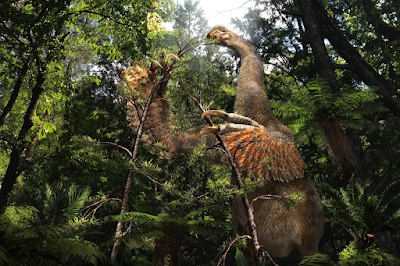Image courtesy of SA/Webb, NASA & CSA, JADES
Collaboration, J. Witstok, P. Jakobsen, M. Zamani
Joel Kontinen
How can galaxies
form? A study has them forming some 239 million years ago after the Big Bang.
A galaxy found at
the dawn of the universe appears to be the earliest known evidence of cosmic
reionisation, the period when the universe was lit up for the first time.
Following the big bang, the early universe was filled
with hot hydrogen and helium gas that scattered photons, making the cosmos
somewhat opaque. Over the next few hundred million years, as stars began to
shine, their light ionised the hydrogen and helium, enabling photons to flow
freely and making the universe transparent, though the exact timing of this is
uncertain.
Joris Witstok at
the University of Copenhagen in Denmark and his colleagues used the James
Webb Space Telescope (JWST) to study a galaxy called JADES-GS-z13-1-LA. The
galaxy is seen 330 million years after the big bang, making it one of the
earliest known galaxies in the universe.
Ultraviolet light from the galaxy suggests it was
surrounded by a bubble about 200,000 light years across, which might be the
result of its starlight interacting with the surrounding cosmic hydrogen.
Seeing evidence for this so early in the universe is “beyond even our wildest
expectations,” says Witstok.
Michele Trenti at
the University of Melbourne agrees that the observations are consistent with
the process of cosmic reionisation. “It’s both surprising and
exciting,” says Trenti. “I would not expect the ultraviolet light emitted from
this galaxy to reach JWST. The cold neutral hydrogen gas that we were expecting
would have surrounded the galaxy should have blocked the photons. We are
witnessing the onset of reionisation.”
The nature of the small galaxy itself is not entirely
clear; it might be shining brightly because of a population of massive hot and
young stars, or a powerful central black hole. “This would be the earliest
known evidence for a supermassive black hole at the centre of a galaxy,” says
Trenti.
While astronomers have seen other, later galaxies with
a similar bubble around them, JADES-GS-z13-1-LA is the earliest known example. “It’s a benchmark,” says Richard Ellis at
University College London. “It tells us that this galaxy must
have been around for quite a while, and pushes that little bit further back to
the beginning of when galaxies first emerged from darkness.”
JWST was able to unearth the secrets of this galaxy
only by staring at it for a relatively long time, about 19 hours. Witstok is
hopeful we might soon see other early evidence for cosmic reionisation. “We
have a few more candidates,” he says. “We might find it even further [back in
time], or maybe this is the most extreme that it gets.”
The millions of years in this study are not based on
science but on evolutionary thinking,
Source:
Jonathan O’Callaghan 2025 An early hint of cosmic dawn has been seen in a distant galaxy | New Scientist 26 March
































